
Craigievar Castle is a pinkish harled castle or fortified country house 6 miles (9.7 km) south of Alford, Aberdeenshire, Scotland. It was the seat of Clan Sempill, and the Forbes family resided here for 350 years until 1963, when the property was given to the National Trust for Scotland by William Forbes-Sempill, 19th Lord Sempill.

Dunbeath Castle is located on the east coast of Caithness, 2 kilometres (1.2 mi) south of Dunbeath, in northern Scotland. Although a castle has stood here since the 15th century, the present building is of mainly 17th-century origin, with 19th-century extensions. The castle is a 19,669 sq ft (1,827.3 m2) Category A listed building and the grounds are included in the Inventory of Gardens and Designed Landscapes in Scotland.
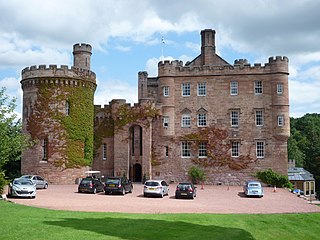
Dalhousie Castle is a castle in Cockpen, Midlothian, Scotland. Dalhousie Castle is situated near the town of Bonnyrigg, 8 miles (13 km) south of Edinburgh. The castle was the seat of the Earls of Dalhousie, the chieftains of Clan Ramsay.
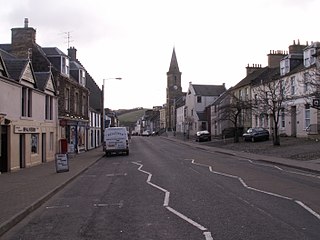
Newburgh is a royal burgh and parish in Fife, Scotland, at the south shore of the Firth of Tay. The town has a population of 2,171, which constitutes a 10% increase since 1901 when the population was counted at 1,904 persons.

Newburgh is a coastal village in Aberdeenshire, Scotland. The village dates to 1261 AD, when Lord Sinclair wanted to establish a chapel in the area. Originally built as a school, somewhat later the chapel of Holy Rood was established.
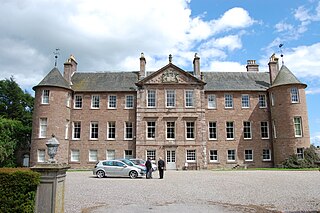
Brechin Castle is a castle in Brechin, Angus, Scotland. The castle was constructed in stone during the 13th century. Most of the current building dates to the early 18th century, when extensive reconstruction was carried out by architect Alexander Edward for James Maule, 4th Earl of Panmure, between approximately 1696 and 1709. The castle is a 37,748 square feet (3,506.9 m2) Category A listed building and the grounds are included in the Inventory of Gardens and Designed Landscapes in Scotland.

Clan Sinclair is a Highland Scottish clan which holds the lands of Caithness, the Orkney Islands, and the Lothians. The chiefs of the clan were the Barons of Roslin and later the Earls of Orkney and Earls of Caithness.

Kilravock Castle is located near the village of Croy, between Inverness and Nairn, in the council area of Highland, Scotland. It was begun around 1460 and has been the seat of the Clan Rose since that time. The castle is a composite of a 15th-century tower house and several later additions. The original name for the castle was Cill Rathaig; Scottish Gaelic meaning "church at the small circular fort".

Taymouth Castle is situated to the north-east of the village of Kenmore, Perth and Kinross, in the Highlands of Scotland, in an estate which encompasses 450 acres (180 ha). It lies on the south bank of the River Tay, about 1 mile (1.6 km) from Loch Tay, in the heartland of the Grampian Mountains. Taymouth is bordered on two sides by mountain ranges, by Loch Tay on the third and by the confluence of the rivers Lyon and Tay on the fourth.
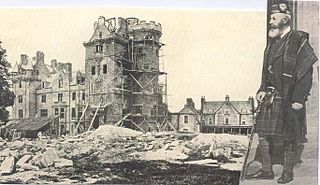
Beaufort Castle or Castle Dounie is a Baronial style mansion built in 1880 and incorporating older building work. It is situated on the right bank of the River Beauly near the town of Beauly in Inverness-shire and is 1 mile (1.6 km) north of Kiltarlity and 13 mi (21 km) west of Inverness. There has been a castle on the site since the 12th century. Beaufort Castle is the traditional seat of the Lords Lovat, Chiefs of Clan Fraser of Lovat.

Clan Drummond is a Highland Scottish clan. The surname is rendered "Druimeanach" in modern Scottish Gaelic.

Roslin Castle is a partially ruined castle near the village of Roslin in Midlothian, Scotland. It is located around 9 mi (14 km) south of Edinburgh, on the north bank of the North Esk, only a few hundred metres from the famous Rosslyn Chapel.

Castle Leod is the seat of the Clan Mackenzie. It is a category A listed building, and the grounds are listed in the Inventory of Gardens and Designed Landscapes of Scotland, the national listing of significant gardens. It is located near Strathpeffer in the east of Ross-shire in the Scottish Highlands.
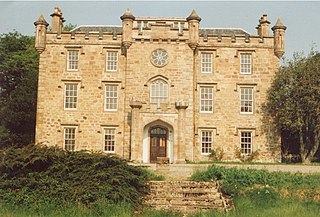
Teaninich Castle is situated north of the village of Evanton and just south of the town of Alness in Ross and Cromarty, Scotland.

Ackergill Tower is located on the coast of Sinclair's Bay, about 4 km north of Wick, Caithness, in northern Scotland. It was built in the early 16th century, and is a category A listed building. The building is a five-storey oblong tower house. The four-storey wing to the rear was added in the early 18th century.
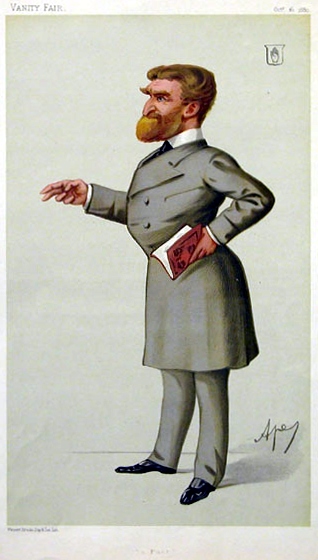
Sir John George Tollemache Sinclair, 3rd Baronet was a Scottish landowner and Liberal politician who sat in the House of Commons from 1869 to 1885.

Dingwall Castle was a medieval fort and royal castle in the town of Dingwall, eastern Ross-shire, Scotland.

Udny Castle is a tower house in the parish of Udny, southwest of the village of Pitmedden and northeast of the hamlet of Udny Green, Aberdeenshire, in the northeast of Scotland. The area is generally flat but the castle is sited on the highest ground and can be seen for a considerable distance. Its exact construction date is unknown, but its foundations probably date from the late 14th or early 15th century. Additional storeys were added and a later extension, described as a "modern mansion", was incorporated but subsequently demolished. It is a Category A listed building.
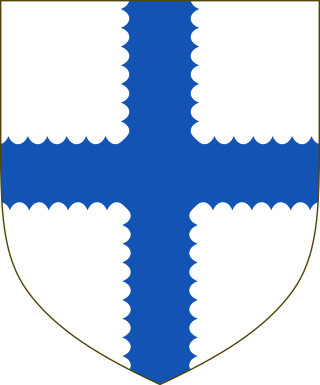
William Sinclair of Newburgh, Aberdeenshire was a Scottish nobleman and the 3rd Lord Sinclair. In The Scots Peerage by James Balfour Paul he is designated as the 2nd Lord Sinclair, but historian Roland Saint-Clair designates him the 3rd Lord Sinclair in reference to his descent from his grandfather, Henry II Sinclair, Earl of Orkney, the first Lord Sinclair. Roland Saint-Clair references this to an Act of the Scottish Parliament in which William Sinclair's son, Henry Sinclair, 4th Lord Sinclair, was made Lord Sinclair based on his descent from his great-grandfather, Henry II Sinclair, Earl of Orkney, the first Lord Sinclair. Bernard Burke, in his a Genealogical and Heraldic Dictionary of the Peerage and Baronetage of the British Empire, agrees with Roland Saint-Clair and says that Henry Sinclair was "in reality" the fourth holder of the title of Lord Sinclair.
John Udny was a Scottish diplomat who served as British Consul at Venice and Leghorn.




















